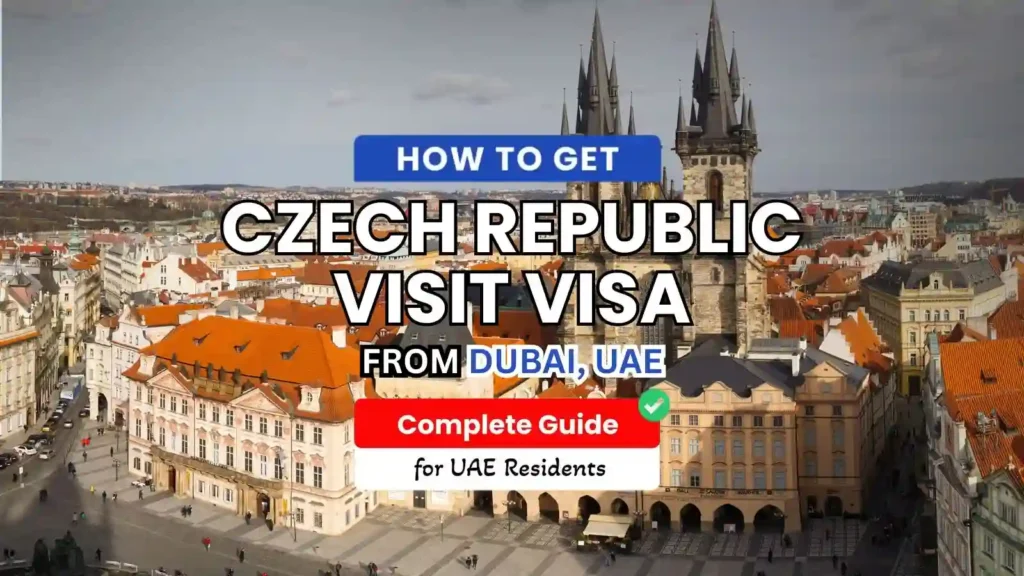
The Czech Republic has a way of drawing you in—Prague’s stone bridges at sunset, café corners in Brno, fairy-tale lanes in Český Krumlov. If that’s the trip you’re picturing, getting the visa right is your first, very manageable step. Here’s a professional, human-friendly walkthrough that keeps the paperwork tidy and your plans on track.
Start with the basics: do you need a visa?
-
UAE nationals (Emirati passport holders): you can visit visa-free for up to 90 days in any 180-day period under the Schengen rules.
-
Expatriate residents in the UAE: most nationalities need a Schengen short-stay visa (Type C) before travel, unless you already hold a valid multiple-entry Schengen visa.
If you’re staying longer than 90 days (study, work, research), you’ll be looking at a national long-stay visa through Czech authorities rather than a Schengen short stay.
Choose the right path
For holidays, family visits, or short business trips, Type C (short stay) is the fit. That single choice guides the forms you’ll fill, the documents you’ll gather, and where you’ll apply.
Tip: Plan your route first. Under the “main destination” rule, you apply to the country where you’ll spend the most nights. If nights are split evenly, apply to the country of first entry. If the Czech Republic is your longest stop or first entry on an even split, you’re in the right place.
Build your document pack (make it neat and consistent)
Think of this as your travel story on paper. Each item backs up a detail you’ve declared.
-
Passport valid for the trip (Schengen requires at least 3 months beyond your planned exit; many centers prefer 6 months) with two blank pages.
-
UAE residence visa valid 3+ months beyond your return.
-
Completed and signed Schengen application form.
-
Two passport photos (recent, white background, Schengen size).
-
Travel plan: return flights (reservations are fine at the application stage) and a simple day-by-day outline.
-
Accommodation: hotel bookings, rental, or an invitation letter from a host in the Czech Republic (include address and contact).
-
Bank statements for the last three months showing steady funds. If there’s a large recent deposit, add a one-line note (bonus, sale, refund).
-
Travel medical insurance covering at least €30,000 across the Schengen Area for the full trip.
-
Cover letter (short and clear): purpose, dates, cities, who’s paying, and why you’ll return to the UAE (job, family, tenancy, studies).
Optional but helpful: an employment or no-objection letter stating your role, salary, and approved leave; for business trips, add a Czech company invitation.
Book your submission slot (and biometrics)
In the UAE, the Czech Republic works through VFS Global. Book your appointment online, choose a convenient date, and build in a small buffer—peak seasons fill quickly. At the appointment, you’ll submit your file and give biometrics (fingerprints and photo) unless you’ve done Schengen biometrics in the last 59 months.
Presentation matters: clean prints or PDFs, clear file names, and dates that match across every document. Tiny mismatches cause big delays.
Fees and payment
Visa fees vary by age, nationality, and category; VFS also charges a service fee. You’ll typically pay at the center by card or cash. Fees are non-refundable—another reason to keep your documents tight.
Processing timelines (and a realistic buffer)
Typically, it takes about 15 calendar days to process a Czech short-stay visa after your file is lodged, although holiday periods may prolong this. To be safe apply at least four weeks before you fly. Make use of the time to rework your schedule and have confirmations in one folder. Partnering with Global Sky Visa The most trusted visa agency in Dubai will keep you updated with the requirements, so when your approval arrives, all you need to do is pack and board your flight.
Passport return and quick checks
When your passport is ready, VFS will notify you for collection or courier delivery. Before you celebrate, check the visa sticker carefully:
-
Name and passport number
-
Validity window (from–to dates)
-
Number of entries (single/double/multiple)
-
Duration of stay (e.g., 15, 30, 45 days)
If anything looks off, raise it immediately—fixing it now is far easier than at the border.
The 90/180 rule in plain language
Your Schengen short stay allows a maximum of 90 days in any rolling 180-day period. Multiple entry doesn’t increase those days; it only lets you split them across trips. Keep a simple tally if you’re a frequent traveler.
Make your file easy to say “yes” to
-
Keep the story consistent. Dates, addresses, and names should match in the form, bookings, and letters.
-
Show ties to the UAE. Employment letter with approved leave, tenancy or property documents, family responsibilities—include what’s relevant.
-
Be specific, not dramatic. “Prague 4 nights, Český Krumlov 2 nights, Brno 2 nights; return flight on [date]” reads better than an essay.
-
Budget like an adult. Your statements should comfortably support your plan (stays, meals, transport, a buffer).
Common pitfalls you can avoid
-
Booking non-refundable flights before a decision. Use hold fares or flexible rates until the visa is issued.
-
Fuzzy scans and cropped pages. Submit clear, full-page copies.
-
Photo specs ignored (wrong size/background). Retake them to Schengen standards.
-
Unexplained deposits in bank statements. Add a brief note to avoid extra questions.
-
Entry category mismatch. If you plan a UK or Balkans side trip and then back to Schengen, request double or multiple entry up front.
A quick, workable timeline
-
Week 0: Gather documents, buy insurance, complete the form, write the cover letter.
-
Week 1: VFS appointment and biometrics; pay fees.
-
Weeks 2–3: Processing (be reachable for any clarifications).
-
Week 3–4: Collect passport, verify the sticker, finalize bookings.
Travel day: have these handy
Keep in your cabin bag: passport with visa, first-night address, return ticket, insurance summary, and enough payment options (card + some cash). Border questions are simple when your answers are on paper.
Final word
If the Czech Republic is your main stop, the Schengen process is straightforward when you plan it like a tidy checklist: choose the right visa, tell one clear story with your documents, respect the 90/180 rule, and apply with time to spare. Do that, and the visa becomes a formality—leaving you free to decide more enjoyable things, like sunrise on the Charles Bridge or a late-night trdelník before the tram ride home.
